Persian cats stand as one of the most venerable and captivating feline breeds, with their lineage tracing back as far as the 1600s. Historically, these magnificent creatures graced Persian records as “the long-haired beauties,” a testament to their enduring charm, as noted by Maggie Shuter, a Certified Feline Behavior Consultant. Throughout history, Persian cats journeyed the world, serving as cherished companions to caravan travelers and explorers alike. Even Queen Victoria herself was captivated by their allure, owning two Persians, and in 1871, the breed made a show-winning appearance at the inaugural modern cat show, solidifying their status as a sought-after companion.
Today, Persian cats continue to hold a prominent place among the most popular cat breeds, captivating enthusiasts with their serene demeanor and striking appearance. Easily identifiable by their distinct “smooshed-in” faces, large expressive eyes, and luxuriant coats, they come in over 50 shades and color combinations. These stocky felines typically measure between 10–15 inches in height and weigh 7–13 pounds. While they require a considerable commitment to grooming, Persian cats are known for being docile, intelligent, and exceptionally well-suited as companions in tranquil households, offering deep affection to their devoted human families. This comprehensive guide will delve into every aspect of Persian Cat Care, ensuring these beautiful pets lead healthy, happy lives.
Understanding Your Persian Cat: Temperament and Traits
Persian cats possess a unique temperament that perfectly complements their elegant appearance. They are typically reserved and may be wary of new people initially, preferring to observe from a distance. However, once they form a bond, these cats become deeply attached to their family members. As Maggie Shuter highlights, “They are known to be relaxed and to enjoy bonding by sitting with humans and being petted rather than showing love through play, though they certainly do have occasional bursts of energy.” This gentle nature makes them ideal companions for those seeking a calm and affectionate pet. While they do enjoy a good snuggle, their playful moments are often more lackadaisical than rambunctious, tending towards quiet observation or gentle interaction rather than energetic antics.
Interestingly, the iconic flat face of the Persian cat was not always a characteristic of the breed. This distinctive “peke” look, reminiscent of Pekingese dogs, evolved as a result of a random genetic mutation that became highly desirable among breeders. This aesthetic preference, while charming, has unfortunately introduced specific grooming and medical care needs that are crucial for the well-being of these flat-faced felines. Understanding these inherent traits and potential predispositions is fundamental to providing optimal care for your Persian cat.
Key Health Considerations for Persian Cats
Persian cats generally have a lifespan averaging 10–13 years. However, due to their unique genetic makeup and distinctive physical traits, they are predisposed to certain health conditions. Being aware of these potential issues and taking proactive measures, such as considering pet insurance for your Persian kitten, can significantly contribute to their long-term health and quality of life. Responsible pet parenthood for Persians involves vigilance and regular veterinary check-ups to address any emerging health concerns promptly.
Hydrocephalus
Persian kittens with extreme brachycephaly (the “smooshed-in” face) face a heightened risk of developing hydrocephalus, a serious condition characterized by the abnormal expansion and accumulation of cerebrospinal fluid (CSF) within the brain’s cavities. Signs of congenital hydrocephalus typically manifest within the first few weeks to a year after birth. These can include seizures, a noticeably dome-shaped head, abnormal breathing patterns, and a general failure to thrive. Cats diagnosed with severe hydrocephalus may require surgical intervention to manage the condition and improve their prognosis.
Brachycephalic Airway Syndrome
Brachycephalic airway syndrome encompasses a collection of upper airway issues commonly observed in flat-faced breeds, including Persian cats and Pekingese dogs. The physical characteristics associated with brachycephaly, such as narrowed nostrils (stenotic nares), an elongated soft palate, or a collapsed larynx (voice box), frequently lead to breathing difficulties. An abnormally small trachea can further exacerbate these respiratory challenges. This syndrome can severely limit a Persian cat’s capacity for exercise and their tolerance for heat, making them particularly vulnerable during warm weather or after exertion. The risks are often amplified in overweight cats, senior felines, or those suffering from allergies. It is critical to recognize that if you ever notice your cat breathing with an open mouth, this is considered a medical emergency requiring immediate veterinary attention.
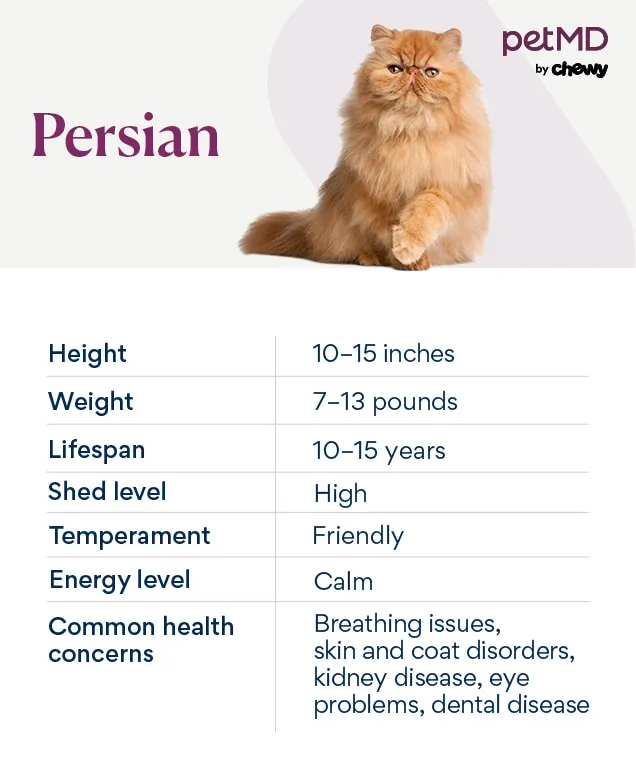 Illustrative depiction of a Persian cat's breed characteristics
Illustrative depiction of a Persian cat's breed characteristics
Skin and Coat Disorders
Persian cats are renowned for their abnormally long, thick fur, a trait resulting from a genetic mutation that affects hair protein function. While beautiful, this luxuriant coat makes them particularly susceptible to various skin and coat issues. They are more prone to developing fungal and bacterial skin infections compared to other breeds. Proper and consistent grooming, as detailed in a later section, is paramount in preventing these common dermatological problems and maintaining the integrity of their magnificent fur.
Polycystic Kidney Disease (PKD)
Polycystic kidney disease (PKD) is a significant genetic condition prevalent in Persian cats, where multiple cysts form within the kidneys, progressively leading to permanent damage. This damage impairs the kidneys’ vital functions, including waste filtration, fluid balance, and proper hormone production. Thankfully, genetic testing offers a crucial preventative measure by identifying carriers, allowing responsible breeders to avoid perpetuating the disease in future generations. Prospective Persian kitten owners should inquire about the breeding parents’ test results. Additionally, at-home DNA kits can detect PKD in cats before symptoms even appear, offering an early warning system for pet parents.
Symptoms of PKD are highly similar to those of general kidney disease in cats and can become evident as early as 6 months of age, though they typically appear around 7 years of age. If you observe your Persian cat drinking more water, urinating more frequently, experiencing a loss of appetite, or losing weight, a prompt check-up with their veterinarian is essential for early diagnosis and management.
Progressive Retinal Atrophy (PRA)
Persian cats may also be predisposed to progressive retinal atrophy (PRA), a degenerative eye condition where the retina, the light-sensitive tissue at the back of the eye, gradually deteriorates. Symptoms of PRA worsen over time, with night blindness often being the first noticeable sign, typically appearing in young cats between 1–2 years of age. Ultimately, this progressive condition leads to total blindness. While there is currently no cure for PRA, cats who lose their sight can still lead high-quality lives with some adjustments and extra care from their owners. When selecting a Persian kitten from a responsible breeder, always ask for the genetic test results of the kitten’s parents to assess the risk of PRA.
Dental Disease
While all cat breeds are susceptible to dental disease, Persian cats face an increased risk due to their distinctive flat facial structure, which can cause their teeth to become overcrowded. This overcrowding creates ideal pockets for food particles and bacteria, accelerating plaque and tartar buildup and leading to issues such as gingivitis and periodontal disease. The most effective methods for preventing dental problems in Persian cats include daily tooth brushing and scheduling regular veterinary check-ups that incorporate professional dental cleanings. Proactive dental hygiene is a cornerstone of comprehensive Persian cat care.
Optimal Nutrition for Persian Cats
Persian cats are not typically known for being the most active felines. Stephen Quandt, a certified Feline Training and Behavior Specialist, notes, “Some people refer to them as lazy, but they just enjoy sleeping and sitting calmly.” This lower activity level means that careful attention must be paid to their diet to prevent them from carrying excess weight, which can exacerbate existing health issues and lead to new ones. Proper nutrition is a fundamental aspect of comprehensive Persian cat care, directly impacting their overall health and vitality.
To ensure your Persian cat’s nutritional needs are fully met, it is crucial to select a complete and balanced food. This food should adhere to the recommendations set by the Association of American Feed Control Officials (AAFCO) for their specific life stage, whether they are a kitten, an adult, or a senior cat. After choosing an appropriate food, consult with your veterinarian to determine the precise number of calories your individual cat should consume daily, taking into account their unique lifestyle, age, and activity level. This personalized approach prevents overfeeding and supports a healthy weight.
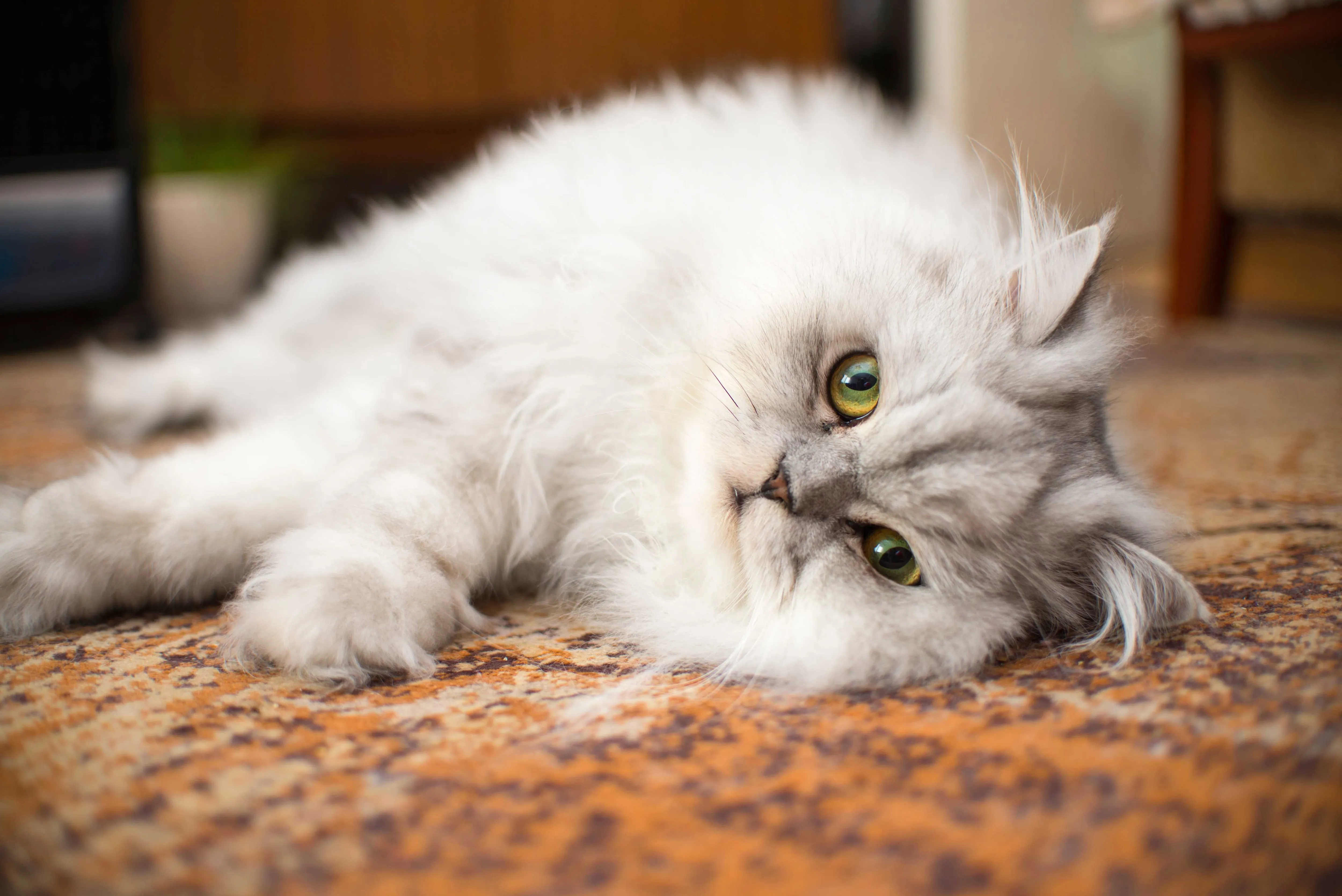 A beautiful silver Persian cat resting calmly on a textured rug
A beautiful silver Persian cat resting calmly on a textured rug
How To Feed a Persian
In their natural environment, wild felines typically hunt and consume small meals multiple times throughout the day. Mimicking this natural pattern by feeding indoor cats two or more small meals daily can be the most biologically appropriate and beneficial approach. Because domestic cats are not generally adept at regulating their own food and calorie intake when food is constantly available, free-feeding (leaving food out all day) is generally not recommended for Persian cats, as it can easily lead to obesity and other weight-related health concerns.
How Much Should You Feed a Persian?
The exact amount of food a Persian cat requires depends on several factors, including their age, activity level, and desired body condition. The World Small Animal Veterinary Association (WSAVA) provides a helpful chart as a rough guide for calculating a cat’s daily calorie needs based on their weight. However, your veterinarian remains the most reliable resource for determining the precise and appropriate amount of food for your specific Persian cat, taking into account all individual variables.
If your Persian cat becomes overweight, your veterinarian may suggest a dietary adjustment. This could involve a reduction in their daily caloric intake, a switch to a specially formulated prescription weight-management food, or a combination of both strategies to help them safely and effectively reach a healthier weight. Addressing obesity is a critical component of proactive Persian cat care, as excess weight can compound many of their breed-specific health challenges.
Nutritional Tips for Persian Cats
A high-quality, complete, and balanced cat food that meets AAFCO’s nutritional adequacy statement will supply your Persian cat with all the essential nutrients, vitamins, healthy fats, and proteins they require for optimal health. In specific cases where health issues are present or a preventative approach is needed, your veterinarian might recommend supplementing their diet with additional nutrients:
- Omega Fatty Acids: These beneficial fats, particularly Omega-3 and Omega-6, are known to significantly improve skin and coat health. Given that Persian cats are prone to various skin issues due to their long fur, incorporating additional omega fatty acids into their diet can help alleviate or prevent common dermatological problems. If your Persian frequently experiences skin issues, discuss with your vet whether a supplement is recommended.
- Insoluble Fiber: For Persian cats that experience frequent hairballs, your veterinarian might suggest a hairball formula that includes ingredients rich in insoluble fiber, such as rice hulls, pea fiber, and cellulose. These types of fiber aid in moving ingested hair efficiently through the digestive tract, preventing it from accumulating in the stomach and subsequently being coughed up onto your carpet.
Behavior and Training for Your Persian Companion
Persian cats are creatures of habit and thrive in environments that offer a calm and quiet lifestyle. Both Shuter and Quandt emphasize that these felines are “especially susceptible to changes in the environment around them,” meaning consistency and a stable routine are key to their well-being. Their serene nature makes them generally better suited for households with older children who understand how to interact gently, rather than homes with toddlers or babies who might be too boisterous.
While they appreciate their personal space and quietude, Persian cats can coexist peacefully with other well-mannered cats and even friendly dogs that do not exhibit aggressive or overly playful chasing behaviors. However, any introductions to new pets should always be conducted slowly, carefully, and under supervision to ensure a smooth transition and minimize stress for all animals involved. Patience is paramount when integrating new companions into a Persian cat’s established territory.
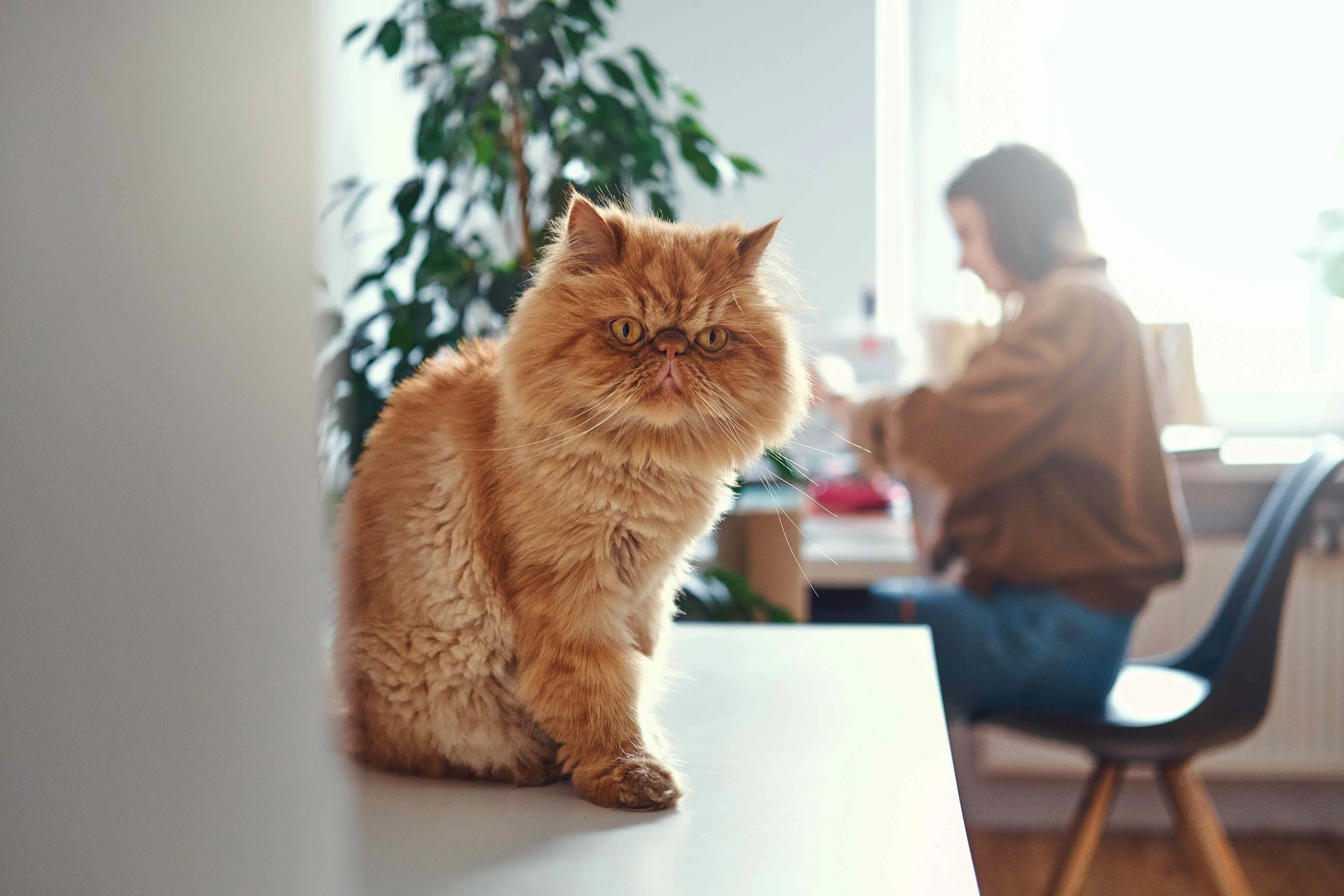 An orange Persian cat sitting attentively on a wooden desk
An orange Persian cat sitting attentively on a wooden desk
Persian Behavior
Unlike some more vocal breeds, such as Siamese cats, Persians are generally not very chatty. When they do choose to vocalize, their meows are typically very soft and sweet, often indicating a gentle request or greeting. Their preferred activities usually involve lounging in a sunbeam, comfortably nestled in their favorite bed, or engaging in quiet birdwatching from a window perch. While playfulness can vary with age, most Persians enjoy more lackadaisical play sessions rather than boisterous, high-energy games. They are more observers than participants in household antics, preferring tranquil interactions.
Persian Training
Despite their calm demeanor, Persian cats are intelligent animals capable of learning and responding to cues. They can be effectively trained with the help of positive reinforcement techniques, such as clicker training, which capitalizes on their intelligence and desire for gentle interaction. As with any cat, the level of success in training will largely depend on the individual cat’s personality, as well as the pet parent’s patience, consistency, and commitment to the training process. Short, positive, and rewarding sessions are most effective.
Fun Activities for Persian Cats
While not known for their athleticism, Persian cats have a variety of activities that bring them joy and enrichment. These simple pleasures contribute significantly to their overall happiness and reinforce the bond with their owners:
- Sunbathing: Finding a warm, sunny spot to nap is a favorite pastime.
- Lounging in their favorite bed: A plush, comfortable bed offers security and a personal retreat.
- Being petted: Gentle strokes and cuddles are highly cherished forms of affection.
- Being groomed: Many Persians enjoy the regular brushing sessions, which double as bonding time.
- Gentle play: Engaging with feather wands or soft toys in a calm manner provides mental and physical stimulation without overexertion.
Comprehensive Grooming Guide for Persian Cats
According to Stephen Quandt and Maggie Shuter, Persian cats are unequivocally “high-maintenance cats”. Their hallmark thick, long coats and distinct flat facial features necessitate a consistent and special grooming regimen. This dedication to grooming is a critical component of Persian cat care, essential not only for their appearance but also for preventing painful skin conditions and ensuring their comfort. Regular grooming also serves as an excellent opportunity for bonding between a Persian cat and their human companion.
Skin Care
Quandt strongly suggests that Persian cats benefit from weekly baths to actively prevent their dense fur from matting. Regular bathing helps to remove loose hair, distribute natural oils, and maintain coat health. If your Persian is prone to developing skin infections, it is vital to consult your veterinarian. They may recommend a specific medicated shampoo, possibly a prescription formula, tailored to address and prevent dermatological issues effectively. Consistent skin care is crucial for these long-haired beauties.
Coat Care
While undeniably beautiful, the thick and often oily coats of Persian cats are highly susceptible to matting. To prevent the formation of painful mats, which can pull on the skin and cause significant discomfort, it is imperative to comb and brush your cat every single day. During these grooming sessions, ensure that the teeth of the comb penetrate through the dense topcoat to reach and detangle the thick undercoat. Skipping at-home grooming sessions, even for a few days, can quickly lead to large, difficult-to-manage mats that often require professional grooming, which might even necessitate shaving your Persian’s coat for their comfort. Understanding cat grooming prices can help you budget for professional care if ever needed.
Eye Care
Persian cats are known for their large, expressive, round eyes, which come in a stunning array of bright colors, including copper, green, hazel, or blue. However, these flat-faced felines naturally produce more tears than most other cat breeds. This increased tear production can lead to unsightly tear stains around their eyes and, more importantly, create persistently moist fur that is prone to uncomfortable irritation and infections.
To prevent these common issues, Maggie Shuter recommends gently cleaning your Persian’s eyes every day. A small cotton face cloth rinsed in warm water is typically effective for wiping around the eyes and carefully removing any visible stains or moisture. It is crucial to consult your veterinarian before applying any commercial cleaners or medications near your cat’s eyes, as some products can be irritating or harmful.
Ear Care
Persian cats possess small, fluffy ears that characteristically tilt slightly forward. As an integral part of their routine grooming, their ears should be regularly inspected for cleanliness and gently cleaned if any dirt or debris is present. Ear cleaning should be done carefully, typically with a vet-approved solution or warm water on a cotton ball, avoiding deep insertion into the ear canal. If you observe any indications of an ear infection, such as redness, a foul odor, excessive scratching, or unusual debris in the ear canal, it is essential to consult your veterinarian immediately for proper diagnosis and treatment.
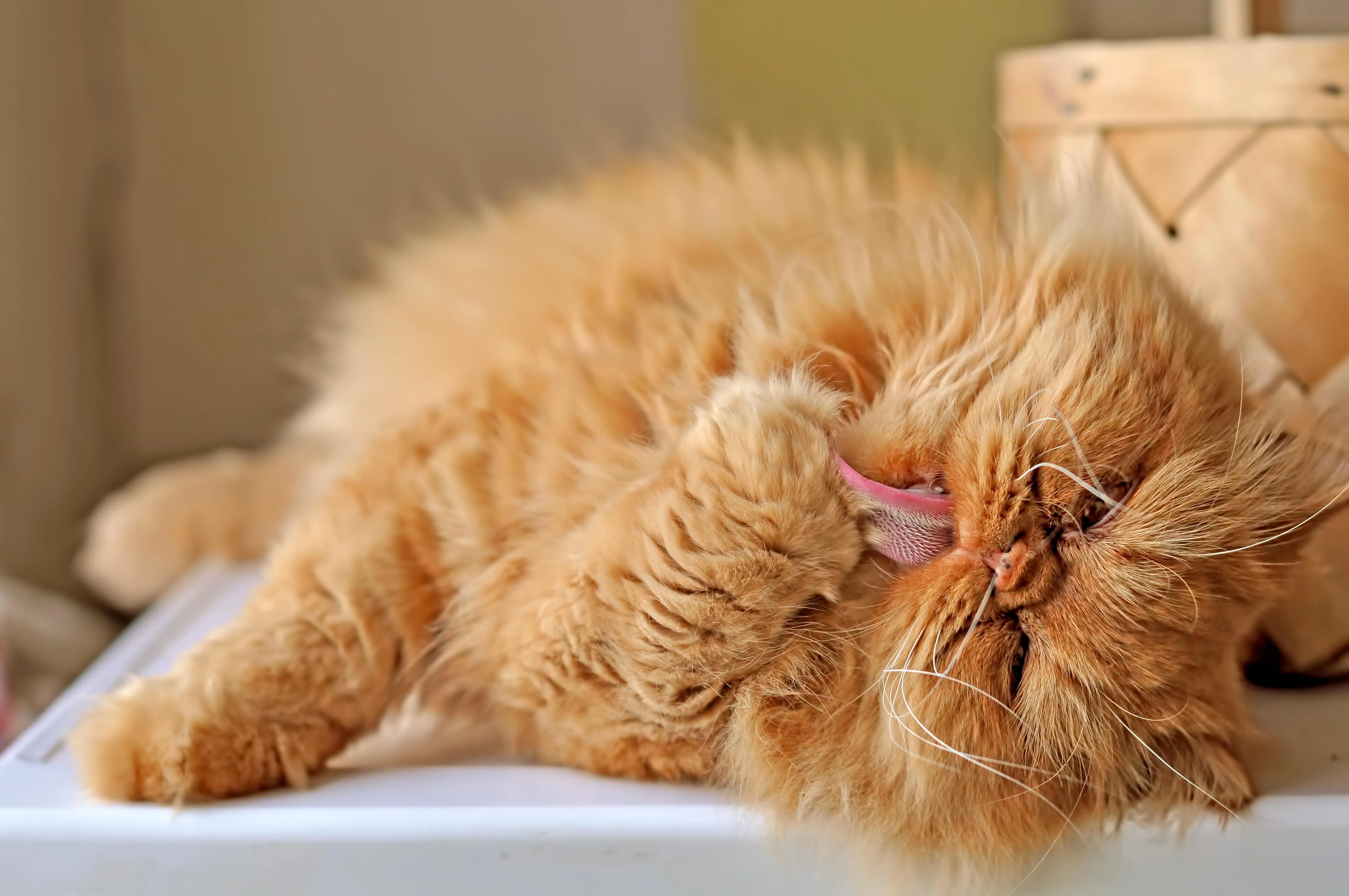 Close-up view of an orange Persian cat meticulously cleaning its paw
Close-up view of an orange Persian cat meticulously cleaning its paw
Making Your Home Persian-Friendly
Persian cats are not recognized for their athleticism or a penchant for scaling heights. Therefore, while elaborate cat shelves might not be a necessity for your Persian, they deeply appreciate the finer, more comfortable things in life. A sun-drenched windowsill perch, allowing them to engage in their favorite pastime of birdwatching, or a plush, soft bed for extended snoozing sessions, will be far more appreciated by these relaxed felines. Their serene disposition and innate love for routine make Persian cats exceptionally well-suited for homes or apartments occupied by older children, single individuals, seniors, or anyone who embraces a low-key, tranquil lifestyle.
While their temperament is undeniably laid-back and undemanding, the grooming requirements of Persian cats are quite the opposite. These truly high-maintenance felines derive immense pleasure from daily brushing and grooming routines. These sessions not only keep their dense, beautiful fur mat-free and healthy but also serve as an invaluable opportunity for deep bonding with their pet parents. Embracing these regular grooming rituals is a key aspect of Persian cat care, fostering both their physical well-being and emotional connection.
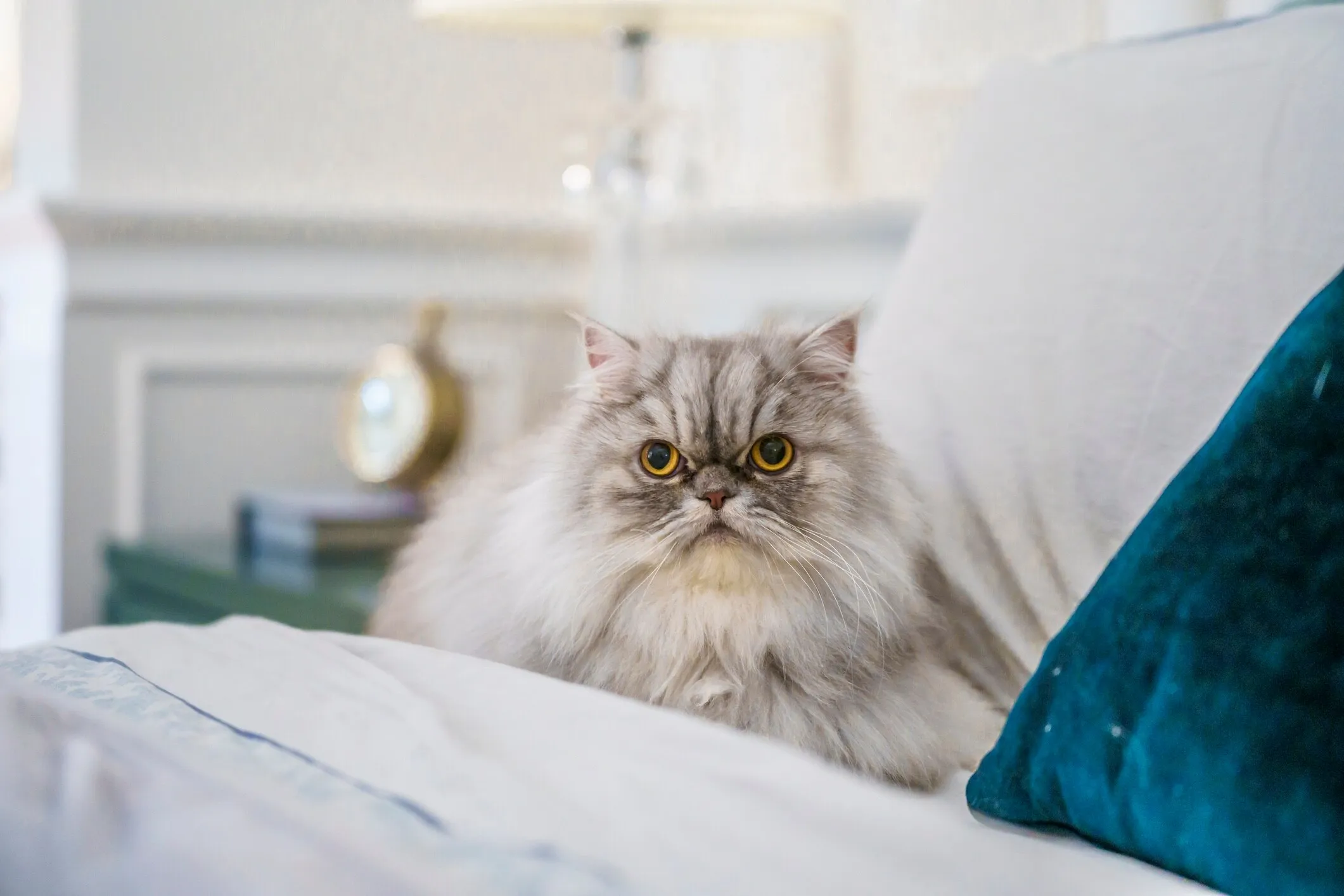 A silver Persian cat comfortably settled in a human bed
A silver Persian cat comfortably settled in a human bed
Conclusion
Caring for a Persian cat is a deeply rewarding experience that involves understanding their unique needs and dedicating yourself to their well-being. From their distinctive flat faces to their luxurious, long coats, these “long-haired beauties” require specific attention to health, nutrition, and especially grooming. While they may present as high-maintenance in their care requirements, the deep bonds they form, their docile personalities, and their gentle companionship make every effort worthwhile. By prioritizing their health through regular veterinary care, providing optimal nutrition, maintaining their exquisite coats, and creating a calm, loving home environment, you can ensure your Persian cat thrives and lives a long, happy, and comfortable life as a cherished family member. Explore more expert advice on cat care on our website to further enhance your pet parenting journey!
Sources
- Maggie Shuter, Certified Feline Behavior Consultant
- PetMD: Various articles on Persian cat health, nutrition, and care.
- Nature.com: Article on hair protein function and genetic mutations affecting fur length.
- Association of American Feed Control Officials (AAFCO): Guidelines for complete and balanced pet food.
- World Small Animal Veterinary Association (WSAVA): Guidelines and charts for pet nutrition.
- Stephen Quandt, Certified Feline Training and Behavior Specialist
- Dog Care Story: Internal link to cat grooming prices.
